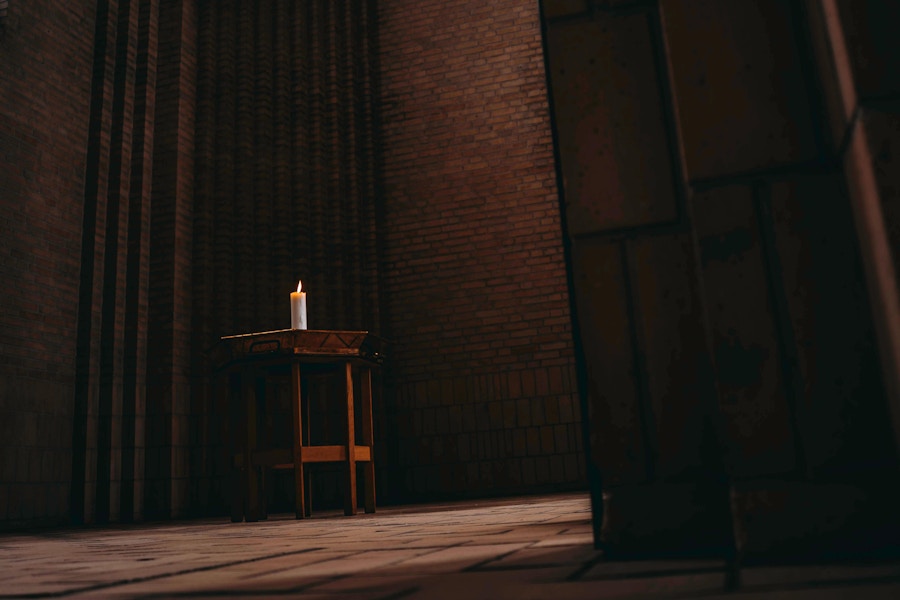Lent is a season of repentance and preparation. In many churches, it is a time when those who will be baptized prepare for their new life with God. It’s a time when those who have been estranged from the church can be reconciled to the body of believers. It’s also a time for all of us to think about the ways we have drifted from the faith. The common theme uniting these three functions of Lent is that they all involve a turning toward God with intention and reflection on the past. We hope that as Christians mature and grow they will become more and more like Christ. But the church in its wisdom assumes that we will fail, even after our baptism. The church presumes that life is long and that zeal fades, not just for some of us but for all of us. So it has included within its life a season in which all of us can recapture our love for God and his kingdom and cast off those things that so easily entangle us.
Today Lent is known as the forty days of fasting in preparation for Easter. In the West, Lent begins on Ash Wednesday and concludes on Holy Saturday, the day before Easter. Exactly how we ended up with this exact period of time is something of a mystery. In the first few centuries of the church’s life, there was a one- or two-day fast in preparation for Easter. Some scholars think that this fast was eventually extended to what we now call Holy Week. We went from a few days to a week-long preparation. One week grew to three weeks, and finally forty days. During these forty days baptismal candidates were prepared to be received into the church on Easter.
As best as we can tell, however, the fasts related to Holy Week developed apart from what is now called Lent. It seems there was a period of fasting that preceded baptism even when the baptism was not connected with Easter. Those fasts varied in length, but there is some evidence that the forty-day pre-baptismal fast was popular in Alexandria.
Whatever its precise development, it’s clear that the early Christians thought that baptism was serious and required preparation. I think this is wise. Becoming a Christian is no small matter. To transition from believing that you live in a world where death is the end to one in which an Almighty God calls dead things to life is much more significant than choosing what to have for breakfast. We should have space to reflect on the full significance of the change.
After the council of Nicaea set a particular date for the celebration of Easter, many throughout the church began to see the feast of the Resurrection as the best time to bring people into the church. It was also a fitting time to bring back into the church those who had strayed away. The link between Lent and Easter, then, was a collision of different factors. The season of fasting linked to baptism and the reconciliation of those estranged from the church were connected to the fasting in preparation for Easter, including Holy Week.
So Lent came to be about three things: the preparation of new converts for baptism, the reconciliation of those estranged from the church, and a general call for the whole church to repent and renew its commitment to Jesus.
In those early centuries, the practice varied. In the East the Lenten fast lasted seven weeks, but Saturdays and Sundays weren’t counted in the total, so there were actually only thirty-six fast days. In the West, the fast was only six weeks, but they ended up with thirty-six days, too, because only Sundays were not counted. Western Christians eventually added the four days from Ash Wednesday to the first Sunday of Lent to give us the number forty. Today in most Western churches the days of Lent are calculated by counting forty days from Ash Wednesday through the end of Holy Week, excluding Sundays.
Fasting practices also varied. In some contexts particular foods were removed from the diet during Lent; in other places the number of meals was reduced. This may seem like the kind of creeping legalism that would send Protestants running for the hills. But hold on.
All this variation is actually rather freeing. There was never a single way of doing Lent given to us from on high that we must follow in order to be right with God. The history of the development of Lent is like our spiritual lives. The church stumbled around trying different things and doing its best to discern together the best ways to use this period of time to bring us closer to God. We should not see the season of Lent as a series of rules but as a gift of the collected wisdom of the church universal. It is one of many tools of discipleship pointing us toward a closer walk with Jesus. This does not mean that we should treat Lent as a spiritual buffer to choose this or that. It means that we should take the wisdom that the church offers us as wisdom but not legalism.
There may be some benefits to adopting practices that may not initially make sense to us because Christians before us have struggled, discerned, and prayed their way into the practices that are now our heritage. I was not baptized at the end of Lent. I was raised in the Black Baptist church, where we got baptized when we heard the gospel and believed. But Lent does hold a particular place in my heart. The season of Lent was my first encounter with liturgical spirituality. It added a new element to my spiritual life.
My first Lent was a pilgrimage. I never left the city I resided in during that time, but I did go on a journey. At a time when I felt adrift spiritually, Lent helped me be aware of the nearness of God. These outward practices took me on an inward journey further into the awareness of God.
Adapted from “We Must Repent: An Introduction to Lent,” from Lent: The Season of Repentance and Renewal by Esau McCaulley. Published 2022 by IVP.
Photo by Daniele Colucci on Unsplash
Text First Published November 2022 · Last Featured on Renovare.org February 2023


